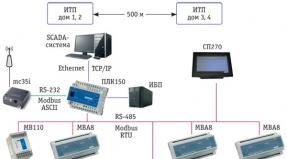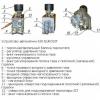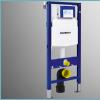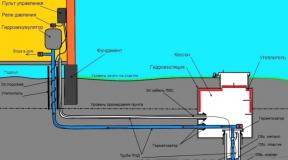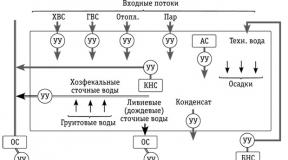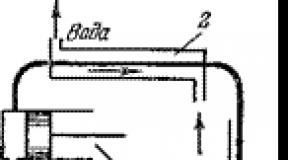Leprosy disease. Leprosy - what it is, symptoms, how leprosy is transmitted, treatment and diagnosis. Internal organ damage
Taxonomy: family Mycobacteriaceae, division Firmicutes, genus Mycobacterium, M. leprae.
Pathogen properties:
Morphology: Gram-positive stick, straight or slightly curved, with pointed and or thickened ends; well stained according to Ziehl-Nielsen. Leprosy balls (“pack of cigarettes”) are formed inside the cells. Acid resistant.
Cultural properties: do not grow on nutrient media
AG structure: group-specific polysaccharide and protein AG
Epidemiology. Anthroponous infection. The source is a sick person. The transmission route is contact, airborne.
Pathogenesis: Once in the body, bacteria penetrate the nerve endings, from there - into the lymphatic and blood capillaries. The pathogen dies and eliminates; the disease can be latent. The likelihood of developing leprosy depends on the state of resistance factors.
Clinic: The incubation period is 4-6 years. There are 5 forms of the disease: polar tuberculoid, borderline tuberculoid, undifferentiated, borderline lepromatous and polar lepromatous.
Tuberculoid: overgrowth of granulation tissue in the skin and mucous membranes.
Undifferentiated: skin rashes, lesions of the nerve trunks
Lepromatous: Infiltrates of red-brown color on the face and distal extremities, loss of eyebrows and eyelashes, lesions of the eyes, lymph nodes are increased in volume.
Immunity: In patients with leprosy, a CIO defect is detected. The degree of his defeat reflects Mitsuda's reaction (with lepromin).
Material: scrapings from the affected areas of the skin and mucous membranes, puncture of the lymph nodes 1. Bacterioscopy: smear according to Ziehl-Nielsen. In the positive case, the intracellular location of mycobacteria in the form of clusters of red sticks ("pack of cigars"), coccobacilli and balls. 2. Bioassay: on armadillos (lepromas are formed in tissues - multiple nodules) 3. Setting an allergic test with lepromin. Two days after administration - erythema and a small papule. It is characteristic of patients with tuberculoid leprosy.
Prevention: no vaccine available.
Treatment: chemotherapy, sulfone drugs, anti-tuberculosis drugs (rifampicin), desensitizers and biostimulants.
73. Pseudomonas aeruginosa - Pseudomonas aeruginosa. Role in human pathology. Toxin formation and pathogenicity. Etiology and pathogenesis. Laboratory diagnosis.
Taxonomy: genus Pseudomonas, family Pseudomonadaceae, division Gracilicutes, causative agent Pseudomonas aeruginosa
Pathogen properties:
Morphology: Gram-negative, straight sticks, located singly, in pairs or in the form of short chains. They are mobile. They do not form a dispute, they have pili (fimbria). Under certain conditions, they can produce capsule-like extracellular mucus of a polysaccharide nature.
Cultural properties: obligate aerobes that grow well on simple nutrient media. A distinctive feature is the limited need for nutrients. Mucus production is a characteristic feature of virulent strains. In liquid media, a grayish-silvery film. On solid media, small convex S-colonies, the phenomenon of rainbow lysis.
Biochemical properties:low saccharolytic activity: does not ferment glucose and other carbohydrates. Restores nitrates to nitrites, has proteolytic activity: it liquefies gelatin.
Antigenic properties:O- and H-antigens.
Toxin formation and pathogenicity: Exotoxin A inhibits protein synthesis. The action is manifested in a general toxic effect, edema, necrosis, art hypotension with collapse, metabolic acidosis, etc.
Exoenzyme S - pathological processes in the lungs.
Cytotoxin-development of neutropenia.
Hemolysin-necrotic lesions.
Endotoxin-pyrogenic response, stimulates inflammation
Neuramidase- disrupts the metabolic processes of substances containing neuraminic acids (connective tissue)
Proteolytic enzymes: elastase breaks down elastin, casein, hemoglobin, fibrin; alkaline protease hydrolyzes proteins.
Epidemiology:Source of a sick person. Infection mechanisms: contact, respiratory, blood, fecal - oral.
Pathogenesis: penetrate damaged tissue. Sow a wound or burn surface. They multiply. Local processes (infection of the urinary tract, skin, respiratory tract). Bacteremia. Sepsis.
Clinic: wound infections, burn disease, meningitis, urinary tract infections, skin infections, eye diseases, sepsis.
Immunity.In the blood serum of healthy and recovered patients, there are antitoxic and antibacterial antibodies, however, these antibodies are type-specific and their role in protecting against recurrent diseases has been little studied.
Microbiological diagnostics.Material for research: blood, pus and wound discharge, urine, sputum. The main diagnostic method - bacteriological examination of clinical material, allows not only to identify the pathogen, but also to determine the sensitivity of bacteria to antimicrobial drugs. During identification, growth on agar, positive cytochrome oxidase test, and detection of thermophilicity (growth at 42C) are taken into account. Serotyping is used for intraspecific identification of bacteria.
The serological method of research is aimed at detecting specific antibodies to bacillus antigens (usually exotoxin A and LPS) using RSC, RPHA.
Treatment: antibiotics (cephalosporins, β-lactams, aminoglycosides). Severe forms - plasma from blood immunized with polyvalent corpuscular Pseudomonas aeruginosa vaccine. For local treatment: antipseudomonal heterologous immunoglobulin. For the treatment of purulent skin infections, burns - Pseudomonas aeruginosa bacteriophage.
Prevention: specific - sterilization, disinfection, antiseptic. Control over contamination of the external environment. Non-specific - immunomodulators. Passive specific immunization with hyperimmune plasma. To create active immunity, vaccines (polyvalent corpuscular Pseudomonas aeruginosa vaccine, Staphylo-Protein Pseudomonas aeruginosa vaccine.
Herpesviruses, classification. Causative agents of chickenpox and herpes zoster, cytomegaly. Pathogenesis. Laboratory diagnosis. Treatment, prevention. The role of herpes viruses in the development of malignant tumors.
Taxonomy: Family Herpesviridae. Subfamilies: Alphaherpesviruses, Betaherpesviruses, Gammaherpesviruses
· Alphagerpesviruses: genus Simplexvirus (herpes viruses type 1 and 2) and genus Varicellovirus (herpes virus type 3)
· Betaherpesviruses: genus Cytomegalovirus (5th type) and genus Roseolovirus (herpes viruses 6A, 6B and 7 types)
· Gammherpesviruses: genus Lymphocryptovirus (4th type)
Herpes virus type 3.
Epidemiology: the reservoir of the pathogen is a sick person, the virus is transmitted by airborne droplets and by contact.
Pathogenesis: the pathogen multiplies in the epithelium of the mucous membrane of the upper respiratory tract, then disseminates through the lymph and bloodstream into the skin. Herpes zoster develops as a result of the reactivation of the virus in the sensitive nodes of persons who have had chickenpox.
Clinic: Chicken pox - incubation period 14 days. It manifests itself as an acute infectious disease, accompanied by fever and papular-vesicular rash on the skin and mucous membranes. During the period of convalescence, the bubbles dry up with the formation of crumbs and healing without the formation of defects.
Shingles - characterized by rashes along the sensory nerves in the form of indistinct pinkish spots. After 24 hours, the rash transforms into groups of painful vesicles surrounded by a clear demarcation zone. The lesions are localized on the chest. Lesions resolve within 2-4 weeks, pain may persist for weeks or months
Microbiological diagnostics: Microscopy of smears according to Romanovsky-Giemsa. Isolation of the pathogen on cultures of human embryo fibroblasts. Detection of Ag of the virus in vesicle fluid by immunodifusion with precipitating sera and determination of the increase in AT titers in paired sera.
Treatment: drugs that reduce itching, analgesics, acyclovir
Prevention: gamma globulin from serum of patients with shingles.
Herpes virus type 5.
Epidemiology: reservoir is a sick person. The pathogen is transmitted through the placenta, by contact, during feeding, during blood transfusions, during sexual intercourse.
Pathogenesis: It affects almost all organs and tissues, causing either asymptomatic carriage or clinically expressed conditions. In case of transplacental infection, lesions of the liver, spleen, eyes, central nervous system, respiratory tract are observed
Clinic: The infection often proceeds subclinically, in rare cases, a serious illness is observed, often with a fatal outcome. For acute form lesions of many internal organs, including the brain, kidneys, liver, and hematopoietic organs, are typical.
Microbiological diagnostics: microscopy of smears according to Romanovsky-Giemsa. Isolation is carried out by infecting cultures of fibroblasts. For express diagnostics, virus Ag is determined in RIF and DNA hybridization. Determination of circulating antibodies is carried out using the methods of RSK, RPHA, RN with paired sera.
Treatment: agents that inhibit viral DNA synthesis
Prevention: live virus as monovaccine or divaccine (in combination with rubella vaccine)
This is a systemic infectious process with a chronic course, caused by mycobacterium leprosy and accompanied by epidermal, visceral manifestations, as well as signs of damage to the nervous system. There are 4 clinical forms of leprosy: lepromatous, tuberculoid, undifferentiated and borderline. Typical signs of leprosy are skin manifestations (erythematous pigment spots, nodules, tubercles), polyneuritis, severe deformity and disfigurement of the face, extremities, etc. Lepromine test, bacterioscopy and pathological examination of biopsy from the affected foci contribute to the diagnosis of leprosy. Treatment of leprosy is carried out for a long time, with repeated courses of antileprosy drugs.
ICD-10
A30 Lepra [Hansen's disease]

General information
Leprosy (leprosy, Hansen's disease) is a low-contagious infection leading to generalized granulomatous lesions of integumentary tissues, peripheral nerves, and in severe cases, the musculoskeletal system, eyes and internal organs. Lepra is considered one of the oldest diseases of mankind, for many centuries it has inspired ominous horror. In the Middle Ages, "lepers" were declared "dead alive", ostracized or isolated for life in specialized hospitals - leper colony. Today, the attitude towards the disease has changed significantly, however, despite the availability of specific treatment, the problem of the incidence of leprosy remains relevant for a number of countries in Asia, Africa, Latin America. According to various sources, in the world from 3 to 12-15 million people are sick with leprosy; more than 500-800 thousand new cases of the disease are diagnosed annually.

Causes of leprosy
Sources of leprosy infection are sick people who excrete pathogens with nasal mucus, saliva, breast milk, seminal fluid, urine, feces, excreted skin leprosy. Also, natural reservoirs of infection can be animals - armadillos and monkeys. Mycobacterium leprosy infection occurs mainly by airborne droplets, less often - with damage to the skin or bites of blood-sucking insects. Cases of infection when applying tattoos are described.
Leprosy is considered a low-contagious disease; infection is usually preceded by regular and prolonged contact with the patient. Healthy people are naturally highly resistant to leprosy. To a greater extent, children are susceptible to leprosy infection, as well as persons suffering from chronic intercurrent diseases, alcoholism, drug addiction. The exact length of the incubation period has not been established; according to various authors, it can range from 2-3 months to 20 years or more (on average, 3-7 years).
Classification
According to the generally accepted classification, there are 4 main clinical types of leprosy: lepromatous, tuberculoid, undifferentiated and borderline (dimorphic). Undifferentiated leprosy is considered an early manifestation of the disease, from which two polar clinical and immunological variants subsequently develop - lepromatous or tuberculoid. The most malignant type, lepromatous leprosy, is characterized by the presence of large amounts of mycobacteria in the body and the negative nature of the lepromin test. With a relatively favorable, tuberculoid type of leprosy, on the contrary, there is a small amount of the pathogen and a positive lepromin reaction.
During each of the variants of leprosy, stationary, progressive, regressive and residual stages are noted. The first two stages are characterized by leprosy reactions - an exacerbation of the foci of the disease, despite the ongoing therapy.
Leprosy symptoms
Lepromatous leprosy
The most unfavorable clinical variant of leprosy, occurring with generalized lesions of the skin, mucous membranes, eyes, peripheral nerves, lymph nodes, internal organs. Skin syndrome is characterized by the presence of symmetrical erythematous spots on the face, hands, forearms, legs, buttocks. Initially, they have a red color, rounded or oval shape, a smooth shiny surface, but over time they acquire a brown-rusty color. After months and even years, the skin in the area of \u200b\u200bthese rashes becomes denser, and the elements themselves turn into infiltrates and tubercles (lepromas).
In the area of \u200b\u200binfiltrates, the skin has a bluish-brown color, increased greasiness, enlarged pores. Sweating in areas of the affected skin first decreases, then completely stops. Loss of eyebrows, eyelashes, beard, mustache is noted. Diffuse infiltrative changes lead to deepening of natural wrinkles and folds of the skin of the face, thickening of the nose, superciliary and zygomatic arches, violation of facial expressions, which causes the face of a patient with leprosy to disfigure and take on a fierce look ("the face of a lion"). Already in the early stages, lepromas are formed in infiltrative foci - painless tubercles ranging in size from 1-2 mm to 2-3 cm, located hypodermally or dermally.
On a smooth, shiny surface with leprosy, areas of skin peeling, telangiectasia can be determined. If untreated, lepromas ulcerate; healing of ulcers occurs for a long time with the formation of a keloid scar. The skin of the armpits, elbows, popliteal, groin areas, scalp is not affected.
With lepromatous leprosy, the eyes are often involved in the pathological process with the development of conjunctivitis, episcleritis, keratitis, iridocyclitis. Typical interest is the mucous membrane of the mouth, larynx, tongue, red border of the lips and especially the nasal mucosa. In the latter case, nosebleeds, rhinitis occur; further - infiltration and lepromas. With the development of leprosy in the area of \u200b\u200bthe cartilaginous septum of the nose, its perforation may occur and deformity of the nose may occur. The defeat of the larynx and trachea in the lepromatous type of leprosy leads to a violation of the voice up to aphonia, stenosis of the glottis. Visceral lesions are represented by chronic hepatitis, prostatitis, urethritis, orchitis and orchiepididymitis, nephritis. Involvement in a specific process of the peripheral nervous system proceeds according to the type of symmetric polyneuritis. With leprosy, sensitivity disorders, trophic and movement disorders (paresis of facial muscles, contractures, trophic ulcers, mutations, atrophy of sweat and sebaceous glands) develop.
The course of lepromatous leprosy is characterized by periodic exacerbations (lepromatous reactions), during which there is an increase and ulceration of leprosy, the formation of new elements, fever occurs, and polylymphadenitis.
Tuberculoid leprosy
The tuberculoid type of leprosy is more benign with damage to the skin and peripheral nerves. Dermatological signs are characterized by the appearance of hypochromic or erythematous spots with clear contours on the skin of the face, trunk, and upper extremities. On the periphery of the spots, flat, dense papules of a reddish-purple hue appear, resembling lichen planus. Merging with each other, the papules form annular plaques (figured tuberculoid), in the center of which a site of depigmentation and atrophy appears. On the affected skin areas, the functions of sweat and sebaceous glands decrease, dryness and hyperkeratosis develop, and vellus hair falls out. In tuberculoid leprosy, the nails are often affected, which become dull gray, thickened, deformed, brittle.
Due to damage to the peripheral nerves, leprosy is accompanied by a violation of temperature, tactile and pain sensitivity. Damage to the facial, radial and peroneal nerves is more common: they thicken, become painful and are well palpated. Pathological changes in peripheral nerves result in paresis and paralysis, muscle atrophy, trophic ulcers of the feet, contractures ("pincer hand", "seal foot"). In advanced cases, resorption of the phalanges and shortening (mutation) of the hands and feet may occur. Internal organs in tuberculoid leprosy, as a rule, are not affected.
Undifferentiated and borderline leprosy
With an undifferentiated type of leprosy, typical dermatological manifestations are absent. At the same time, asymmetric areas of hypo- or hyperpigmentation occur on the skin of patients with this form of leprosy, accompanied by a decrease in skin sensitivity and anhidrosis. The defeat of the nerves proceeds according to the type of polyneuritis with paralysis, deformity and trophic ulceration of the extremities.
Cutaneous manifestations of borderline leprosy are asymmetric pigmented lesions, discrete nodules, or protruding stagnant red plaques. Usually, the rash is localized on the lower extremities. Neurological manifestations include asymmetric neuritis. In the future, undifferentiated and borderline leprosy can transform into both lepromatous and tuberculoid forms.
Diagnostics
Lepra is not such a forgotten disease, and doctors of various specialties have the likelihood of encountering it in clinical practice: infectious disease specialists, dermatologists, neurologists, etc. Therefore, you should be alert and exclude the leprosy process in patients with long-term non-regressing skin rashes (erythema, age spots , papules, infiltrates, tubercles, nodes), violation different types sensitivity in certain areas of the skin, thickening of the nerve trunks and other typical manifestations. A more accurate diagnosis allows for bacterioscopic detection of mycobacterium leprosy in scrapings of the nasal mucosa and affected skin areas, histological preparations of leprosy tubercles and lymph nodes.
The results of the reaction to lepromin allow differentiating the type of leprosy. Thus, the tuberculoid form of leprosy gives a sharply positive lepromin test; the lepromatous form is negative. In undifferentiated leprosy, the reaction to the lepromatous antigen is weakly positive or negative; with borderline leprosy, negative. Functional tests with nicotinic acid, histamine, mustard plaster, and Minor's test are less specific.
Leprue must be differentiated from a variety of diseases of the skin and peripheral nervous system. Among the dermatological manifestations, rashes in the tertiary period of syphilis, exudative erythema multiforme, toxicoderma, tuberculosis and sarcoidosis of the skin, lichen planus, leishmaniasis, erythema nodosum, etc. have a similarity to leprosy. -Mari-Tuta, etc.
Leprosy treatment
Leprosy is currently a curable disease. With widespread skin manifestations, positive results of microscopy or relapses of leprosy, patients are hospitalized in special anti-leprosy institutions. In other cases, patients receive outpatient therapy at their place of residence.
Treatment of leprosy is carried out for a long time and in a complex, course method. At the same time, 2-3 antileprosy agents are prescribed, the main of which are sulfone drugs (diaminodiphenyl sulfone, sulfamethrol, etc.). To avoid the development of drug resistance, drugs and their combination are changed every 2 courses of treatment. The duration of the course of specific treatment for leprosy is several years. Also used are antibiotics (rifampicin, ofloxacin), immunocorrectors, vitamins, adaptogens, hepatoprotectors, iron preparations. In order to increase the immunoreactivity of patients with leprosy, BCG vaccination is indicated.
To prevent disability, from the very beginning of treatment, patients with leprosy are prescribed massage, exercise therapy, mechanotherapy, physiotherapy, and wearing orthopedic aids. The important components of comprehensive rehabilitation are psychotherapy, professional reorientation, employment, overcoming leprophobia in society.
Forecast and prevention
The prognosis of leprosy depends on the clinical form of the pathology and the timing of the initiation of therapy. Early diagnosis and initiation of treatment (within a year of the onset of leprosy symptoms) avoid disabling consequences. In the case of a later detection of leprosy, sensory disturbances, paresis, and disfiguring deformities persist. If untreated, the death of patients can occur from leprosy cachexia, asphyxia, amyloidosis, intercurrent diseases.
The system for the prevention of leprosy provides for the mandatory registration and registration of patients, hospitalization of newly diagnosed patients, dispensary observation of family members and contact persons. General preventive measures are aimed at improving conditions and quality of life, strengthening immunity. Persons who have had leprosy are not allowed to work in the food and communal sectors, children's and medical institutions; cannot change the country of residence.
Leprosy, or leprosy Is one of the oldest known diseases. It is rare in the Soviet Union; quite widespread in (countries of Asia, Africa and South America. Leprosy is a chronic disease in which various organs and tissues are affected, mainly the skin, mucous membranes and the peripheral nervous system.
Pathogenesis and clinic. Only people get sick with leprosy, so a sick person is the source of infection. The method of transmission of the pathogen from a patient with leprosy to a healthy one has not been established, although mycobacteria of leprosy are released in large quantities into the external environment when decay of ulcers on the skin and mucous membranes. Most likely, infection can occur through damaged skin (wounds, scratches, scratches), as well as mucous membranes of the upper respiratory tract. There are known cases of leprosy infection when using the patient's things. The disease is not inherited. The child, separated from the mother’s leprosy patient immediately after birth, remains healthy. Contrary to popular belief, leprosy is not a highly infectious infection. Infection is possible, apparently, only with prolonged and close contact. The incubation period lasts an average of 3-5 years, although cases of the disease are known both after a short (several months) and after a long (up to 15-20 years or more) incubation period.
With good resistance to the body, the disease proceeds benignly (tuberculoid form), and with a decrease in resistance, a severe lepromatous form develops.
Immunity. There is a natural immunity to the disease. Persons in contact with patients for a long time become extremely ill. Acquired immunity is poorly expressed.
Microbiological diagnostics. Diagnosis of leprosy is carried out by microscopy of nasal mucus, scrapings from the affected skin. Smears are prepared from the material and stained according to Zil - Nielsen. In smears, a characteristic arrangement of mycobacterium leprosy is observed: large clusters or an arrangement in the form of a “stockade”. Leprosy bacteria are easier to stain with fuchsin Ziel than mycobacterium tuberculosis, but they lose their color faster when acid is discolored.
For diagnosis, a skin allergic reaction with lepromine is also used, similar to the reaction with tuberculin in tuberculosis.
Prevention and treatment. In recent years, it has become known that with BCG vaccination, a positive reaction to lepromine occurs. The possibility of using BCG vaccine as a means of controlling leprosy is currently being studied. All patients with leprosy are placed in special institutions - leper colony, where they are treated and where they are fully supported by the state. In the leper colony, all conditions for a normal life are created: the able-bodied are provided with paid work, the disabled are provided with a pension.
There are drugs to treat leprosy. Of these, sulfonic (sulfetron, sulfatin, etc.), as well as chowmogry preparations used in combination with sulfonic are most effective. The success of treatment depends on its early onset.
Chronic granulomatous disease, mucous membranes, upper respiratory tract are affected. ways, peripheral nervous system, eyes.
Taxonomy.family Mycobacteriaceae, genus Mycobocterium, species M. leprae.
Morphological and cultural properties:straight / curved stick with rounded ends. Gram-positive, do not form spores and capsules, have a microcapsule, do not have flagella. Acid and alcohol resistance, which determines the color according to Zil-Nelsen. It is not cultivated on artificial nutrient media. It multiplies only in the cytoplasm of the cell by division and forms spherical clusters. A characteristic feature of leprosy cells belonging to macrophages is the presence of a pale nucleus and a “foamy” cytoplasm. Does not form toxins.
Biochemical properties.They utilize glycerin and glucose and have a specific enzyme, O-diphenol oxidase. They have the ability to produce extracellular lipids. Aerobes to identify enzymes on the membrane structures of the microorganism OM: peroxidase, cytochrome oxidase.
Antigenic structure.A pronounced ability to enhance cellular immune responses without the addition of adjuvants. A number of M. leprae antigens are common to all mycobacteria, including the BCG vaccine strain, which is used to prevent leprosy. Species-specific glycolipid with the presence of a trisaccharide was isolated from M. leprae. Anti-glycolipid antibodies are found only in patients with leprosy, which is used to actively identify patients with leprosy when examining individuals using ELISA.
Pathogenesis, clinic:Anthroponosis. The reservoir, the source of the pathogen is a sick person (when coughing, sneezing - it releases bacteria).
The main mechanism of infection is aerogenic, the transmission route is airborne. The entrance gate is the mucous membrane of the upper respiratory tract and damaged skin. The causative agent spreads via the hematogenous pathway, affecting skin cells and the peripheral nervous system. The incubation period of 3-5 years. With high resistance, a polar tuberculoid form of the disease (TT-type leprosy), and at low resistance polar lepromatous form diseases (LL-type leprosy).
Immunity:relative. In areas with massive infection, leprosy can be caused by existing natural or acquired immunity.
Microbiological diagnostics: Material for bacterioscopic examination: scrapings from the skin and mucous membranes of the nose, sputum, punctured lymph nodes. Smears are stained according to Zil-Nelsen. The most important bacterioscopy of scrapings is with LL form, in which M. leprae are detected in all rashes in large quantities. At TT formm. leprae diseases in scrapings are very rarely detected, therefore, the final role in the diagnosis of the disease has a histological examination of biopsy samples of the skin and mucous membranes, which allows us to determine the structure of granulomas.
Serological diagnosis based on the detection of antibodies to phenolic glycolipid in ELISA. At LL formdiseases of the antibody are determined in 95% of cases, and with TT form- in 50% of cases. Monoclonal antibodies have been obtained that allow the determination of leprosy antigens in tissues; PCR is being developed.
Of auxiliary importance is the study of the patient's immune status, including the setting of a lepromine test (lepromin A). In patients LL formthe test is negative, and in patients TT formshe is positive.
Treatment: Sulfone preparations: dapsone, solusulfone. Rifampicin, clofazimine and fluoroquinolones. Methods of gene therapy.
Prevention: There is no specific prophylaxis. For a relative increase in immunity, the BCG vaccine is used, of which Lepromin A is an integral part. A preliminary test is carried out using a lepromin test. Development of genetic engineering vaccines, vaccines using specific antigens from M. leprae.
Related Information:
- I - the causative agent of tuberculosis of birds; 2 - the causative agent of brucellosis; 3 - Vibrion septiqui; 4 - washed streptococcus; 5 - actinomycotic drusen; 6 - Babesh Taurus - Negri
Leprosy is a severe chronic infectious pathology caused by the pathogen Mycobacterium leprae hominis. The source of infection is a person with leprosy.Synonyms: leprosy, Hansen's disease, Phoenician anomaly, St. Lazarus disease and others.
Around 11,000,000 people with leprosy are registered in the world. From a medical and social point of view, leprosy is a serious illness.
Leprosy has been known since ancient times. She was mainly ill in the countries of the Middle East. Already then, separate closed settlements were built for patients, where patients slowly died. A case from the New Testament is known when Jesus healed a whole group of lepers sick.
The prejudiced attitude of society towards patients with leprosy, which are subject to complete physical, social isolation, greatly complicates the problem of identifying cases of the disease and combating it. To this should be added the chronic nature of the course of the disease and the lack of confidence that even after prolonged treatment it is possible to achieve complete liberation of the body from mycobacteria.
WHO drew attention to the problem of leprosy in the first decades of its existence. She was inspired by Raul Follero, who devoted himself to the fight against leprosy. In honor of Follero, WHO registered as early as 1954, January 30, World Leprosy Day. This day should attract the attention of the international community to a comprehensive review and thorough familiarization with the problem of leprosy in the world and the possibility of helping such patients.
Etiology, epidemiology of leprosy
Currently, leprosy is common in Africa, Southeast Asia, South America and Oceania. Very rarely - in Europe and North America. The disease can develop at any age, it has no racial restrictions. The concentration of patients with leprosy in economically undeveloped countries and its connection with overpopulation is noted quite often. An important role in the spread of leprosy is played by exogenous high-risk factors.
Reliably, the method of transmission of the disease is unknown, however, long-term observations of patients note infection with constant contact of a healthy person with sick leprosy. There is no evidence about the transmission to humans of a disease from rodents, fleas, insects and others. An important factor in continuous infection, as well as the inability to trace the site of infection in registered patients, is the fact that asymptomatic contact patients can spread mycobacteria from the nasal cavity long before they are diagnosed with leprosy. It is worth noting that mycobacterium leprosy can spread from lepromatous ulcers of treated patients, from mother's milk, from skin appendages. Lepromatous mycobacteria can probably be transmitted by airborne droplets. They are in soil and in water.
Symptoms, diagnosis of leprosy (leprosy)
The disease has a long incubation period, which can last from six months to several decades, more often - 5-7 years. It is asymptomatic. A long latent period is also possible, manifested mainly in general malaise, unreasonable weakness, coldness, etc.
Two polar forms (types) of leprosy are distinguished - lepromatous and tuberculoid, as well asfour stages of the course of the disease: progressive, stationary, regressive and the stage of residual phenomena. In addition, intermediate or dimorphic leprosy is possible.
Tuberculoid leprosy
Tuberculoid leprosy usually begins with the appearance of a clearly defined hypopigmented spot, within which hyperesthesia is noted. In the future, the spot increases, its edges rise, become roller-shaped with a ring-shaped or spiral-shaped pattern. The central part of the spot undergoes atrophy and sinks. Within this focus, the skin is devoid of sensitivity, there are no sweat glands and hair follicles. Thick spots are usually palpated near the spot, innervating the affected areas. Nerve damage leads to muscle atrophy; especially the muscles of the hand. Often contracture of the hands and feet. Injuries and compression lead to infection of the hands and feet, and neurotrophic ulcers form on the soles. In the future, mutation of the phalanges is possible. When the facial nerve is damaged, lagophthalmus and the keratitis caused by it, as well as a corneal ulcer, leading to blindness, are found.
Lepromatous leprosy
Lepromatous leprosy is usually accompanied by extensive and symmetrical skin lesions relative to the midline of the body. Foci of lesion can be represented by spots, plaques, papules, nodes (leprosy). They have blurry borders, a dense and convex center. The skin between the elements is thickened. Most often, the face, auricles, wrists, elbows, buttocks and knees suffer. A characteristic sign is the loss of the outer third of the eyebrows. The late stages of the disease are characterized by the so-called. “Lion's face” (distortion of facial features and violation of facial expressions due to thickening of the skin), overgrowth of earlobes. The first symptoms of the disease are often nasal congestion, nosebleeds, shortness of breath. Possible complete obstruction of the nasal passages, laryngitis, hoarseness. Perforation of the nasal septum and deformation of the cartilage lead to a retraction of the nasal dorsum (saddle nose). The penetration of the pathogen into the anterior chamber of the eye leads to keratitis and iridocyclitis. Inguinal and axillary lymph nodes are enlarged, but not painful. In men, testicular tissue infiltration and sclerosis lead to infertility. Gynecomastia often develops. The late stages of the disease are characterized by hyposthesia of the peripheral parts of the limbs. A skin biopsy reveals diffuse granulomatous inflammation.
Immunity with leprosy is cellular in nature, it is maximum in patients with tuberculoid leprosy and minimal with lepromatous form. To assess the immune response and differential diagnosis between the two forms of the disease, a lepromin test is used. The reaction to the intradermal suspension of mycobacterium leprosy injected is positive with tuberculoid and negative with lepromatous form.
Diagnosis of leprosy is possible by the presence of clinical symptoms of the disease. Confirming research methods are bacterioscopic and histological.
Treatment, prevention of leprosy (leprosy)
The course treatment is long-term (up to 3-3.5 years) with the appointment of anti-leprosy drugs of the sulfones group (diaphenylsulfone, solusulfone, diuciphon, etc.). The duration of the course is 6 months, a break in treatment is 1 month. Multibacterial leprosy requires the initial administration of rifampicin, dapsone or clofazimine, after which they are transferred to the sulfonic group drugs. Evaluation of the effectiveness of treatment is controlled by bacterioscopic and histological research methods. Currently, 4 leper colony has been preserved in Russia (the place of detection, treatment, isolation, and prevention of leprosy): in Astrakhan, Krasnodar Territory, Sergiev Posad District of the Moscow Region, Stavropol Territory.
The main problem of WHO is the fight against leprosy at the level of primary prevention. Today, the main task should be early diagnosis and effective drug therapy. Secondary prevention measures are also important - the identification of cases of the disease. This can be achieved through primary health care with the active participation of the entire population of a country where cases of leprosy are recorded. In places endemic to leprosy, mass surveys of the population, sanitary-educational work among the population and doctors are carried out. In addition to the epidemiological situation, socio-economic factors are of great importance, which explains the wide spread of the disease among the poorest people in Asia and Africa. In the health systems of these countries, the priority is to expand the services of identifying and treating patients with leprosy and ensuring the availability of modern treatment to all patients. Prevention of leprosy in medical personnel and other persons who, by the nature of their contact with patients, consists in strict observance of sanitary and hygienic rules (frequent hand washing with soap, mandatory sanitation of microtraumas, etc.). Cases of infection by medical personnel are rare.

